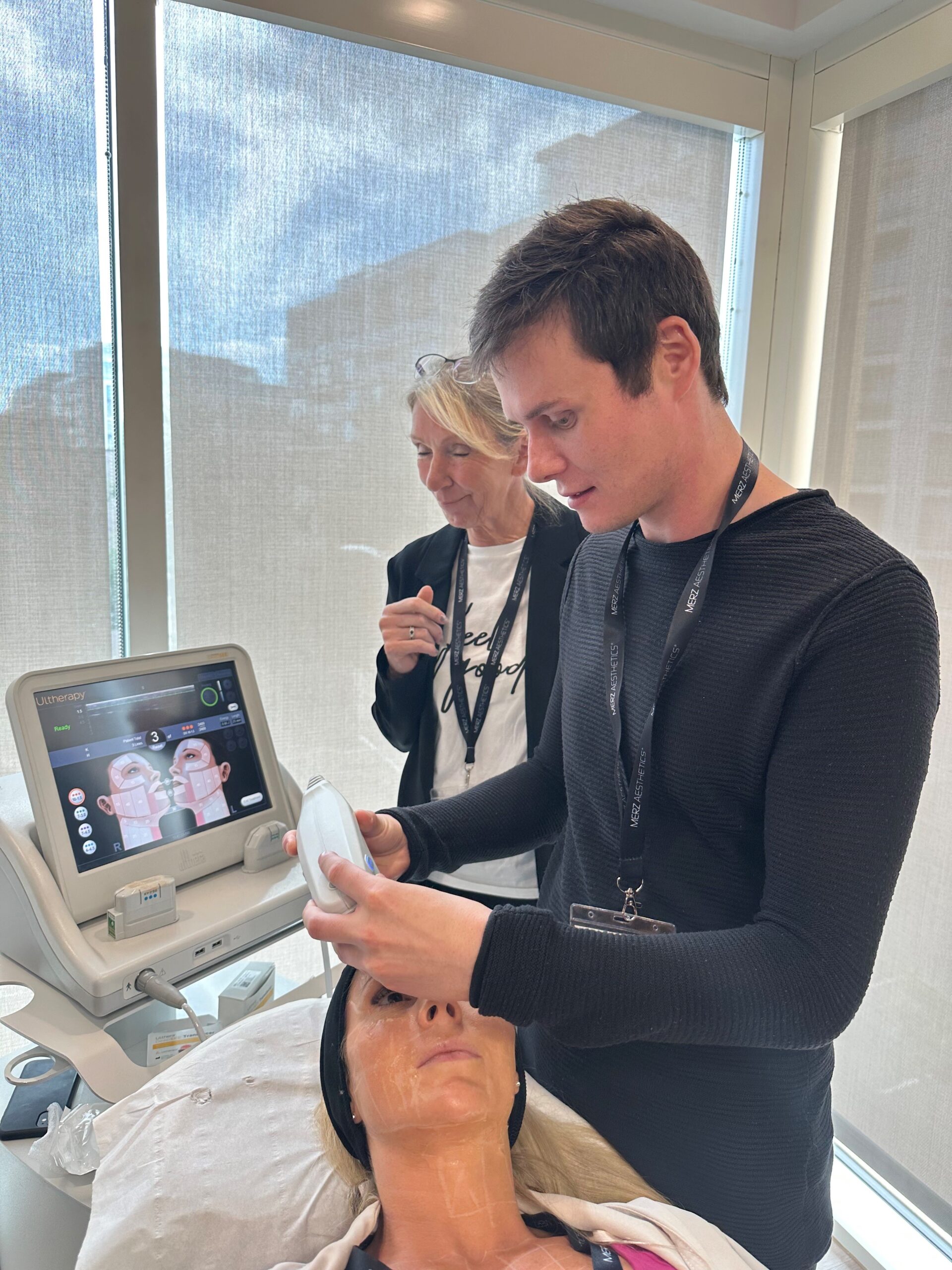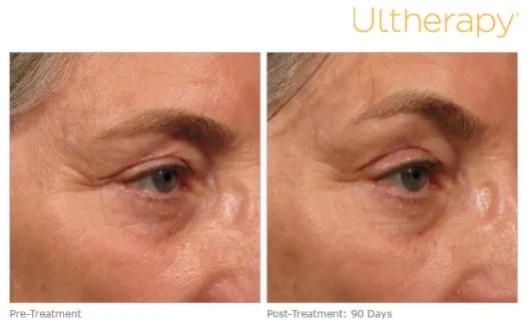Ultherapy: Benefits, procedure, and more – After nine years, why do we still love this procedure?

In an era where people seek non-invasive solutions to maintain their youthful appearance, Ultherapy has emerged as a powerful player in cosmetic treatments. This revolutionary procedure offers a range of benefits, from skin tightening to wrinkle reduction, without surgery. The patients will tell you that I am often heard saying prevention of collagen reduction is essential in ageing.
We start to deplete post 30.
In women, it’s worse at menopause, where we deplete 30% each year.
And that is why fixing with dermal fillers is a little like putting a “band aid” on the problem rather than fixing the solution – RETAIN YOUR COLLAGEN
What is Ultherapy?
Ultherapy is a non-invasive cosmetic procedure that utilizes advanced ultrasound technology to rejuvenate the skin. Unlike traditional surgical facelifts, Ultherapy works beneath the surface, targeting the foundational layers of the skin without causing any harm to the outer layer. Its primary purpose is stimulating collagen production, resulting in the natural tightening and lifting of the treated areas. This groundbreaking treatment is FDA-approved for use on the face, neck, and décolletage.
It simply causes tiny burns and 3 different depths, causing type 1 and type 3 collagen to form.
How Does Ultherapy Work?
The science behind Ultherapy is both fascinating and effective. Ultrasound energy is employed to penetrate deep into the skin, where it generates controlled heat. This heat activates the body’s natural collagen production mechanisms, kickstarting the process of skin rejuvenation. Unlike other methods, Ultherapy targets the deeper layers, producing long-lasting results that gradually improve over several months. It affects all layers and, in reality – Would review your clinical situation at one year for the result – we know that from clinical practice.

Indications for Ultherapy
Ultherapy is a versatile treatment that can address many skin concerns. Its primary indications include:
- Sagging Skin: Ultherapy is highly effective in tightening loose or sagging skin, especially in the neck and jowls.
- Sagging Skin: Wrinkles and Fine Lines: It helps reduce the appearance of wrinkles and fine lines, giving the skin a smoother and more youthful texture.
- Preventive Anti-Ageing: Younger individuals can benefit from Ultherapy as a preventative measure, as it can delay the onset of visible signs of ageing.
Benefits of Ultherapy
The benefits of Ultherapy are numerous, making it a popular choice among those seeking non-surgical cosmetic enhancements:
- Non-Invasive: Ultherapy doesn’t involve surgery, incisions, or downtime, making it a convenient option for busy individuals.
- Natural-Looking Results: The gradual improvement in the skin’s appearance leads to natural-looking, subtle changes.
- Minimal Side Effects: Any side effects, such as redness, swelling, or bruising, are typically mild and temporary.
- Long-Lasting Effects: Results can last up to a year or even more, reducing the need for frequent maintenance.

Risks and Considerations
While Ultherapy is generally safe, it’s crucial to be aware of potential risks and considerations:
- Temporary Side Effects: Some patients may experience redness, swelling, or bruising immediately after the procedure, but these effects usually subside quickly. Nerve damage is also a risk, but we will always discuss this and advise the areas we avoid.
- Provider Experience: Choosing a qualified and experienced provider is essential to achieve the best results and minimize potential risks.
- Variable Results: Results may vary from person to person, and some individuals may require more than one session to achieve their desired outcome.
What to Expect During an Ultherapy Procedure
During an Ultherapy session, patients can expect:
- Consultation: An initial consultation with a qualified provider to discuss treatment goals and expectations. We will scan and decide what depth we can treat and what areas you wish to be treated. Costing is customized to what you require
- Procedure: The treatment typically lasts 60-90 minutes to just over an hour, depending on the areas being treated.
- Discomfort Management: The provider may apply numbing cream or pain management techniques to ensure patient comfort.
Aftercare and Recovery
After an Ultherapy procedure, patients should:
- Follow Post-Treatment Care: Adhere to post-treatment care instructions provided by the provider to minimize discomfort and optimize results.
- Sun Protection: Protect the treated areas from excessive sun exposure and use sunscreen regularly.
Conclusion
In conclusion, Ultherapy stands at the forefront of non-invasive cosmetic procedures, offering remarkable benefits without surgery. Its ability to naturally lift and tighten the skin, reduce wrinkles, and provide long-lasting results makes it a sought-after aesthetic treatment. In Our clinical opinion Ultherapy is the ultimate in age prevention. It can be used with Botox on the brow and fillers on the face, but the only treatment clinically proven to rebuild 42% MORE collagen.
If you’re considering Ultherapy or want to learn more about this innovative treatment, we encourage you to book a consultation, and we can explain your perfect Ultherapy session expert.
Additional Resources
For further information and resources on Ultherapy, please explore the links provided below:
Interesting facts on collagen in the body types, etc
Collagen is a fascinating and crucial protein in the human body. Here are some interesting facts about collagen, its types, and its significance:
- Abundant Protein: Collagen is the most abundant protein in the human body, accounting for about 30% of the total protein content.
- Structural Protein: Collagen is primarily known for its structural support to various tissues, including skin, bones, tendons, ligaments, and cartilage.
- Different Types of Collagen:
- At least 28 different types of collagen are identified in the human body. Type I, II, and III are the most common types, each serving specific functions.
- Type I collagen is the most abundant in skin, bones, tendons, and ligaments. (we want this)
- Type II collagen is the main component of cartilage.
- Type III collagen is found in the skin, blood vessels, and organs. (and this one)
- Skin Elasticity: Collagen plays a vital role in maintaining skin’s elasticity and hydration. As we age, collagen production decreases, leading to wrinkles and sagging skin.
- Wound Healing: Collagen is essential for wound healing. It forms a scaffold for new tissue growth, helping wounds close and heal properly.
- Bone Strength: Collagen is a critical component of bone tissue, providing tensile strength and flexibility. It works with minerals like calcium and phosphorus to maintain bone health.
- Joint Health: Collagen in the form of type II collagen is crucial for the health of joints and cartilage. Collagen supplements are often used to support joint function and reduce pain in conditions like osteoarthritis.
- Hair and Nail Health: Collagen also contributes to the health and strength of hair and nails. Supplementing with collagen may lead to improved hair and nail growth and quality.
- Dietary Sources: Collagen can be obtained from dietary sources such as bone broth, chicken skin, fish scales, and bovine hide. Collagen supplements are also available in various forms.
- Cosmetic Applications: Collagen is widely used in the cosmetic industry in creams, serums, and fillers to enhance skin appearance and reduce signs of ageing.
- Medical Applications: Collagen is used in various medical procedures, including wound dressings, tissue engineering, and reconstructive surgery.
- Genetic Disorders: Some genetic disorders, such as Ehlers-Danlos syndrome and osteogenesis imperfecta, are characterized by defects in collagen production, leading to connective tissue and bone abnormalities.
- Collagen and Digestion: Collagen contains the amino acid glycine, which is thought to support digestive health by promoting the production of stomach acid and aiding in the digestion of food.
- Collagen Production Declines with Age: Collagen production naturally decreases with age, starting in our late twenties. This decline contributes to the visible signs of ageing.
- Collagen Supplements: Collagen supplements have gained popularity for their potential benefits in promoting skin, joint, and bone health. They come in various forms, including powders, capsules, and liquids. However, remember it is TYPE 1 and 3 you are after, and drinks do not guarantee that.
Understanding the significance of collagen in the body and the various types of collagen can help individuals make informed choices about their diet, lifestyle, and potential supplementation to support overall health and well-being.
Back to blog